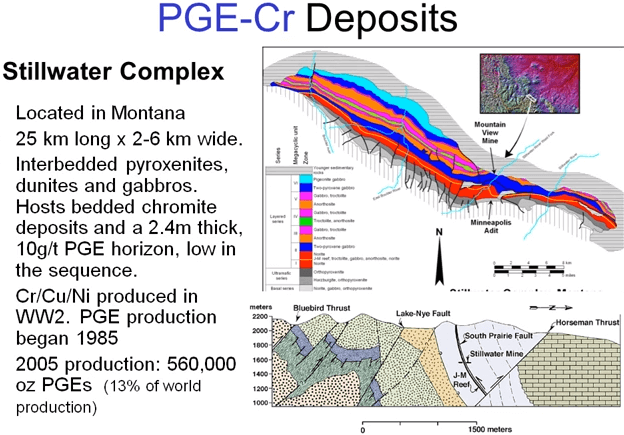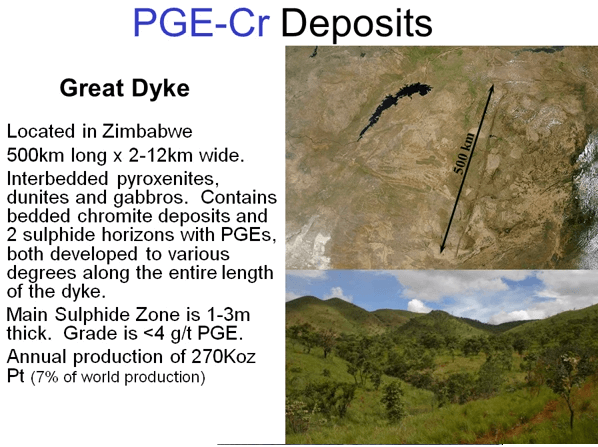 Another major groups of deposits in the mafic layered complexes are platinum group elements and chrome deposits but unlike copper nickel massive sulfides they don’t form as puddles on the floor of the intrusions they form in discrete layers well up in the magma chamber. The PGE’s that’s platinum palladium, rhodium with less amounts of osmium, ruthenium and iridium are often but not always especially related with chromium in the form of chromite. Chromite is an oxide of chromium and you can see discrete black chromite beds between the pale gray anorthosite in this out crop d Bushveld complex it’s almost like sediments. An example of this Cody position of PGE’s and chromite is the so-called UG2 reef in the Bushveld complex. The UG2 reef is the dark material at the top of this photo which was taken in the Bushveld complex; one of the mines there. PGE’s may also be unassociated with chromite and instead be associated with minor amounts of copper nickel sulfide as in the Merensky reef also in the Bushveld complex.
Another major groups of deposits in the mafic layered complexes are platinum group elements and chrome deposits but unlike copper nickel massive sulfides they don’t form as puddles on the floor of the intrusions they form in discrete layers well up in the magma chamber. The PGE’s that’s platinum palladium, rhodium with less amounts of osmium, ruthenium and iridium are often but not always especially related with chromium in the form of chromite. Chromite is an oxide of chromium and you can see discrete black chromite beds between the pale gray anorthosite in this out crop d Bushveld complex it’s almost like sediments. An example of this Cody position of PGE’s and chromite is the so-called UG2 reef in the Bushveld complex. The UG2 reef is the dark material at the top of this photo which was taken in the Bushveld complex; one of the mines there. PGE’s may also be unassociated with chromite and instead be associated with minor amounts of copper nickel sulfide as in the Merensky reef also in the Bushveld complex.
This is drill core from the Merensky and you can see that here is in fact very little black chromite, there is white feldspars and dark green pyroxenes and olivines but very little of the black chromite. The crystallization from the magma of both PGE and chromite is triggered by certain chemical and temperature conditions. This crystallization process is defined by phase chemistry and is complex. The process is illustrated by simplified phase diagrams like the figure on the top right-hand corner of this slide but I won’t go into it in detail in this Exploration Geology Course. The bottom line is that relatively small changes in temperature and chemistry of the differentiating magma can lead to major and sudden changes in the composition of the crystallizing minerals. Mafic magmas tend to be hotter and more fluid than felsic magmas and as the minerals crystallize they fall to the bottom of the melt and accumulate there, often being winnowed or sorted and eroded by currents in the magma chamber. You can see in the same picture how some of the chromite layers that outcrop appears to split or even cut out as a results of these currents. At first glance the rock looks more like sediment than an igneous intrusion.
Platinum’s main usage is in the auto industry where it is a critical of material in catalytic converters and certain spark plugs but it is also used as catalysts in numerous other applications. Its use in jewelry is growing because platinum metal although it looks like silver it does not corrode or tarnish and it’s significantly harder than either silver or gold. Palladiums principle use is also in catalytic converters although it is less effective than platinum. Chrome is mainly used in hardening steel alloys and anti-corrosion plating of steel but it is also used in yellow and orange pink pigments.
Now let’s take a look at some examples of PGE in chrome deposits.
 Starting with the Bushveld as I mentioned earlier the Bushveld complex is the granddaddy of the mafic layered complexes and it covers an area equivalent to the same size of the state of Utah. In the map in this slide the intrusion is colored red and green it has three main lobes and individual layers can be traced horizontally over a distance of 400 km as you can see in the various vertical sections in the figure at the bottom right those are stratigraphic sections spread out across the basin. The platinum and chrome deposits are in the lower part of the lobes which is the green areas on the map so mineralization out crops around the rim and dip shallowly towards the center of the intrusion rather like in the Sudbury intrusion. Although the Bushveld as a maximum vertical extent of around 10,000 m or 10 km. The Merensky reef is just 30 to 90 cm thick and the UG2 reef is generally less than 50 cm in other words the economic PGE’s have been concentrated into 110,000th of the volume of the intrusion. This is a stunning example of nature’s free upgrading from the average crustal abundance. Platinum to palladium ratio for the Merensky and UG2 vary between 2 to 1 and 12 to 1 in other words the deposits are very high in platinum. In spite of the narrowness of the mineralized layers they are very continuous which assists in mining and the Bushveld counts for 80% of the world’s PGE resources and 60% of its annual production.
Starting with the Bushveld as I mentioned earlier the Bushveld complex is the granddaddy of the mafic layered complexes and it covers an area equivalent to the same size of the state of Utah. In the map in this slide the intrusion is colored red and green it has three main lobes and individual layers can be traced horizontally over a distance of 400 km as you can see in the various vertical sections in the figure at the bottom right those are stratigraphic sections spread out across the basin. The platinum and chrome deposits are in the lower part of the lobes which is the green areas on the map so mineralization out crops around the rim and dip shallowly towards the center of the intrusion rather like in the Sudbury intrusion. Although the Bushveld as a maximum vertical extent of around 10,000 m or 10 km. The Merensky reef is just 30 to 90 cm thick and the UG2 reef is generally less than 50 cm in other words the economic PGE’s have been concentrated into 110,000th of the volume of the intrusion. This is a stunning example of nature’s free upgrading from the average crustal abundance. Platinum to palladium ratio for the Merensky and UG2 vary between 2 to 1 and 12 to 1 in other words the deposits are very high in platinum. In spite of the narrowness of the mineralized layers they are very continuous which assists in mining and the Bushveld counts for 80% of the world’s PGE resources and 60% of its annual production.
There are several chromite layers at various levels in the Bushveld but even so even the chromite has been concentrated into less than 1000th of the total volume of the intrusion. This is a photo of some core from a drill hole through the critical zone of the Bushveld the portions is stratigraphy that host all the PGE mineralization. The Merensky reef is well-developed here and it comprises the lower part of the dark material in the center of the photo. The thick of the normal UG2 underlies the Merensky and makes up the dark section towards the bottom of the picture in the lowermost tray. The two reefs are almost invisible in the photo of a test pit in the left.
The Stillwater layered complex is in Montana and although it’s way smaller than the Bushveld it is still 25 km long however because it’s being tipped up on the edge it’s only 2 to 6 km wide. The majority of the intrusive is composed of ultramafic rather than mafic rocks i.e. pyroxenites and dunites rather than gabbros but as in the Bushveld the chromite and PGE are concentrated in discrete horizons. The Stillwater deposits are platinum poor and palladium rich with nearly 4 times as much palladium as platinum. So although the overall grade of the ore is about 10 g per ton combined PGE’s which is similar to the Bushveld the value of the ore per ton is less than half that of the Bushveld because of the relatively lower price of palladium. For this reason and the fact that the Stillwater complex tends to dip more steeply than the Bushveld and mining is more expensive Stillwater ore deposits have only marginal economics. Chrome, copper and nickel were produced from Stillwater during the Second World War but production of PGE’s only began in 1985. In 2005 Stillwater produced 13% of the world’s production of PGE’s but much of this was obviously as palladium rather than as platinum.
The last example of the PGE and chromium intrusion that I’ll mention is the Great Dyke in Zimbabwe. The Great Dyke is a layered complex with the strike length of 500 km and width of between 3 to 12 km. It is visible as a dark line parallel to the arrow in the satellite photo in the top right-hand picture of this slide unlike the Stillwater complex this long narrow outcrop pattern is its original shape and not due to tilting on edge. Chrome has been produced from the Great Dyke since the 1920s although PGE’s were also discovered in the 1920s earlier production attempts were not successful due to the lower grades than in the Bushveld and the difficulty mining and metallurgical conditions. Worthwhile production in Zimbabwe only began in 1994 and the country now produces about 7% of the world’s platinum mainly through impala platinum and impala platinum’s outlook is for increasing proportions of its platinum production to come from the Great Dyke deposits as oppose to the Bushveld.
So those are some examples of the big PGE chromium deposits.
How to explore for Chromite and Platinum PGE Deposits:
How do exploration methods for these deposits differ from those for the copper and nickel massive sulfide deposits. Well since both are found in large mafic intrusive complex the initial stages are similar and airborne magnetics can help to find the outlines and some of the internal structure of the intrusive bodies and you can see how the lake intrusive complex in Canada shows up clearly as red and magenta in the top right-hand image but unlike massive sulfides chromites and PGE’s don’t have significantly different geophysical characteristics from unmineralized rock. So most geophysics won’t help much in locating the actual mineralization within the intrusives. Once the critical horizon is identified by mapping then seismic surveys may possibly detect the change in the host rocks but otherwise they are going to be limited to geochemistry including soil sampling, trenching and rock sampling if the deposits are near surface or drilling the horizons if they are a lot deeper than that.
PGE’s and chrome deposits are usually associated with large mafic intrusives many of these are layered. The general rule is the bigger the intrusion the better you need the large intrusions to provide enough metal content to be concentrated into a worthwhile deposit. Platinum Element Group and chromite deposits form as thin but laterally continuous layers in the body of the layered intrusions. Exploration for PGE’s and chrome depends on relies mainly on mapping and airborne magnetic surveys to identify the host intrusions and electromagnetics for exploration but then would follow up of mapping and geochemistry to guide the drilling and the main PGE producers are South Africa, Russia, Canada, Zimbabwe and the United States.

